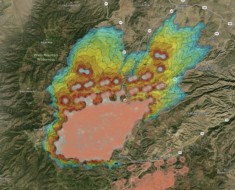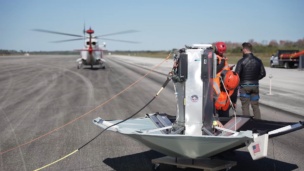Congestion in LEO is on its way up, and in response, the US military is looking to move down.
The Defense Advanced Research Projects Agency (DARPA) has tapped RF-powered in-space propulsion pioneer Phase Four to develop and build a thruster that utilizes the thin air in VLEO as propellant.
- VLEO lies between 90 and 450 km altitude.
- The contract is worth $14.9M over a four-year period.
- It culminates in a long-duration on-orbit demonstration of the air-breathing thruster system.
A new kind of thruster: Based in Hawthorne, CA, Phase Four is working on an RF-powered electric propulsion system designed to be mass-manufacturable and affordable.
- The company has four systems on orbit today.
- Another 82 systems are expected to be delivered over the next 15 months.
- Next on the product roadmap is a multimode system using hydrazine and peroxide fuels, and Phase Four expects to begin taking those orders in Q4.
Phase Four employs 34 full-time and contract employees and is planning to bring on at least 16 more by the end of the year. The team has a production capacity of 160 thrusters per year at its existing facility, but CEO Steve Kiser told Payload he’s keeping an eye out for a larger space to ramp up capacity.
The market for VLEO: When you start trying to fly satellites below LEO, you run into the not-insignificant problem of atmospheric drag. Figuring out a way to sustainably operate satellites in VLEO could potentially open a whole new market for services in the expansive region between where high-altitude balloons and low-flying satellites exist today.
“You’re much, much closer to the Earth,” Jason Wallace, Phase Four’s VP of advanced development, told Payload. “That increases resolution of images, [reduces] latency of communications, and it’s generally…a region of the space environment [where] there is no congestion.”
DARPA is interested in developing the region for military advantage, but according to Phase Four, there’s also interest from commercial organizations.
“There’s no reason that ten years from now…we can’t have thousands of those satellites in orbit, and we intend to capture that market,” Kiser said.
+ While we’re here…Phase Four is also announcing the members of its board of advisors today. On the roster:
- Retired Gen. William Shelton, former commander of Air Force Space Command
- Kevin O’Connell, former director of the Office of Space Commerce
- Ed Perlmutter, former Democratic House rep for Colorado (an outspoken supporter of a 2033 crewed mission to Mars while on Capitol Hill)
- Jeff Grant, president of the Space Foundation and board of trustees member of The Aerospace Corporation




